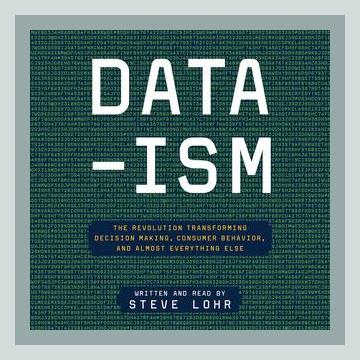Technology and Digital TransformationData Analytics
Introduction
“Data-ism: The Revolution Transforming Decision Making, Consumer Behavior, and Almost Everything Else” by Steve Lohr, published in 2015, dives into the transformative impact of big data and data analytics on diverse aspects of modern life. Lohr explores how data is redefining decision-making processes, shaping consumer behavior, and influencing various sectors including business, healthcare, and governance. By detailing numerous real-world examples, Lohr demonstrates the influential role of data in the contemporary landscape, and how individuals and organizations can leverage this revolution for improved outcomes.
I. The Emergence of Data-ism
Lohr introduces the concept of “Data-ism” as a new cultural and technological phenomenon where decisions are increasingly based on data and analytics rather than intuition or experience. He posits that the proliferation of data from myriad sources—social media, sensors, transactions—has ushered in this era.
Action Point: Embrace data-driven decision-making by incorporating data analytics tools and platforms in everyday decision processes.
Example: General Electric (GE) uses sensors on jet engines to collect vast amounts of performance data, which are then analyzed to predict maintenance needs and improve efficiency.
II. Impact on Business
The book illustrates how businesses are leveraging data to optimize operations, enhance customer satisfaction, and drive innovation. Lohr discusses “smart data” within enterprises, highlighting companies like Google and Amazon.
Action Point: Implement data analytics strategies to identify customer preferences and improve product offerings.
Example: Amazon’s recommendation engine, which analyzes customer behavior and purchase history to suggest products, resulting in increased sales and customer engagement.
III. Healthcare Transformation
Lohr explores how data analytics is revolutionizing healthcare by facilitating personalized medicine, predictive diagnostics, and efficient treatment protocols. Data from electronic health records, wearable devices, and genomic sequencing are integral to this change.
Action Point: Utilize health data analytics to improve patient care and health outcomes.
Example: The CancerLinQ initiative collects data from cancer patients across America to find patterns that can improve treatment strategies, monitor patient progress, and optimize resource allocation.
IV. Consumer Insights and Behavior
Understanding consumer behavior through data analytics is another significant theme. Lohr explains how companies analyze data from social media, online browsing, and purchasing to glean insights into consumer preferences and behaviors.
Action Point: Leverage social media analytics to understand and predict consumer behavior.
Example: Netflix analyzes viewer data to tailor its content recommendations, ensuring higher user retention and engagement rates.
V. Enhancing Decision-Making
Data’s role in improving decision-making processes is central to the book. Lohr discusses the shift from gut-feeling decisions to data-backed strategies in various fields, from sports to governance.
Action Point: Use data-driven models to support strategic decisions in your organization.
Example: The Oakland Athletics’ use of Sabermetrics, a statistical analysis approach, to make player recruitment decisions and optimize team performance.
VI. Data-Driven Governance
In governance, data analytics is employed to enhance transparency, improve public services, and optimize resource allocation. Lohr mentions initiatives that use data to improve urban living conditions.
Action Point: Advocate for and participate in data-driven civic initiatives
Example: New York City’s use of data analytics to identify illegal buildings and prioritize safety inspections, effectively reducing the number of fatal building accidents.
VII. Ethical and Privacy Concerns
The ethical implications and privacy concerns surrounding big data are also addressed. Lohr emphasizes the need for policies and frameworks to protect individual privacy while enabling the benefits of data analytics.
Action Point: Implement robust data privacy policies and educate stakeholders on ethical data use.
Example: Europe’s General Data Protection Regulation (GDPR) which sets strict guidelines on data collection and processing, aiming to protect personal data and privacy.
VIII. Challenges of Big Data
Lohr does not shy away from the challenges of working with big data, such as data quality issues, the need for skilled data scientists, and potential biases in data interpretation.
Action Point: Invest in training and development programs for data analytics skills within your organization.
Example: McKinsey’s report on the shortage of skilled data scientists highlights the need for organizations to prioritize data literacy and training to harness the full potential of data analytics.
IX. The Future of Data-ism
Finally, Lohr looks ahead to the future of Data-ism, predicting that data analytics will become even more integrated into everyday life, with advancements in artificial intelligence and machine learning driving further innovation.
Action Point: Stay updated with the latest trends in data analytics and continuously integrate advanced technologies to stay competitive.
Example: IBM’s Watson, an AI system that uses data to provide insights across various industries—from healthcare diagnostics to financial services, demonstrating the potential of emerging technologies in the data-revolution.
Conclusion
Steve Lohr’s “Data-ism” provides a comprehensive overview of the data revolution, backed by numerous real-world examples of how data analytics is transforming various sectors. By embracing data-driven strategies, understanding the ethical implications, and staying informed about advances in the field, individuals and organizations can harness the power of data to drive better decision-making, innovate, and achieve greater efficiency and impact.
